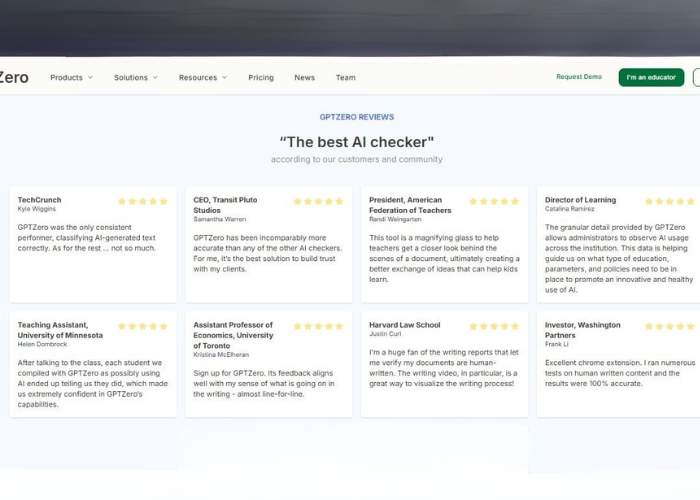The first time I ran one of my blog posts through GPTZero, I had that same uneasy feeling I get when airport security pulls me aside for a “random” check. You know you haven’t done anything wrong, but you also suddenly forget what shoes are.
GPTZero is one of the big names in the AI detection game. And not just big—it’s been everywhere. Classrooms, college boards, editorial meetings, even awkward Thanksgiving dinner debates about whether the valedictorian’s speech was written by ChatGPT or not.
So, I rolled up my sleeves and decided to test it like a real person would. Not in a sterile lab. But in the wild. With coffee stains on my keyboard and too many tabs open. And let me tell you—it was a ride.
What Is GPTZero, and Why Should Anyone Care?
Let’s break this down. GPTZero is an AI detection tool designed to answer a very modern question: Did a machine write this? Or, more dramatically: Is the writer real?
We live in a world where AI can mimic humans alarmingly well. GPTZero steps in as the lie detector, trying to catch sneaky generative models in the act. It looks at stuff like perplexity and burstiness (we’ll come back to those) to determine whether your text is the product of a human brain… or an algorithm.
Educators love it. Journalists eye it warily. Students fear it. But does it actually work?
Short answer: Kinda. Long answer? Keep reading.
First Glance Breakdown
| Feature | Rating (out of 5) | Notes |
| UI & Accessibility | 4.2 | Clean, but not overly friendly |
| Detection Accuracy | 3.8 | Gets it right most of the time—but not always |
| Speed | 4.5 | Fast results, minimal lag |
| Clarity of Results | 3.6 | Could use more context/explanation |
| Free Tier | 4.0 | Enough to test the waters |
| Emotionally Satisfying? | 2.5 | Cold and robotic—ironically |
Testing GPTZero: My Oddball Experiments
So, I ran four types of content through GPTZero:
- Pure Human Writing – my old journal entries from 2017 (peak emotional chaos).
- GPT-4 Generated Essays – well-structured but soulless pieces on obscure topics.
- Human-AI Hybrid Writing – where I rewrote an AI draft with my own flair.
- Casual Conversations – text messages, emails, rants.
The results?
- It nailed the obvious AI essays. No hesitation.
- It mostly recognized my journal entries as human—although one was flagged “mixed,” which… rude.
- The hybrid ones confused it. Half of them were marked AI-written even though I’d rewritten them to the point of exhaustion.
- My text messages? All passed as human. Including the one where I sent “lol” four times in a row. Somehow, that was proof enough.
Understanding GPTZero’s Metrics (Without Needing a PhD)
Two terms you’ll bump into here: Perplexity and Burstiness.
- Perplexity: Measures how “predictable” your writing is. AI-generated text is usually smoother, more consistent, and hence more predictable. Low perplexity = suspicious.
- Burstiness: Humans write in fits and starts. Long sentences, short ones. Tangents. Rants. We’re messy. AI? Not so much.
GPTZero’s logic is basically: if it’s too smooth, too clean, or too grammatically disciplined, it might be machine-made.
Makes sense… but also raises questions. What about students who write like robots because school trained them that way? Or non-native speakers who keep it simple?
The Human Side of the Story
Here’s where things get personal.
I teach writing workshops. I mentor folks who learned English later in life. I also freelance in editorial work. So I’ve seen it all—brilliant essays flagged as “AI-written” because they’re clean. And awful, robotic drivel that somehow squeaked by undetected.
GPTZero doesn’t account for style diversity. Nor does it consider emotional nuance. If I pour my heart out in a meticulously written piece about grief, I don’t want a machine telling me I sound “too perfect to be real.”
That stuff stings.
And it matters. Because tools like this are influencing grades, jobs, and reputations. They should be held to a high standard. Higher than “eh, we’re about 70% sure.”
Pros & Cons Table (Keepin’ It Real)
| Pros | Cons |
| Fast and mostly accurate | Struggles with hybrid or edited content |
| Doesn’t require login for quick use | Lacks detailed reasoning for its verdicts |
| Free plan available | No emotional feedback or constructive notes |
| Great for obvious AI detection | False positives possible, especially with ESL writers |
| Clean design | “AI-written” label feels final and judgmental |
Context Is Everything – And GPTZero Needs More of It
Say I write a short, clear summary of World War II. Sounds robotic? Maybe. But maybe I’m just good at writing summaries. GPTZero doesn’t know my intention. It doesn’t ask, “Did you write this after 12 hours of caffeine-fueled research, or did ChatGPT barf it out in 3 seconds?”
What I’d love? A feedback system.
Something that says: “This feels AI-like because the sentence structure is repetitive. Want suggestions to humanize it?” Or: “This might be a false positive—your writing style is just very consistent.”
Instead, we get a green or red label, like we’re being scanned by a robot bouncer.
Who’s It Really For?
GPTZero’s sweet spot is education. Teachers need something—anything—to deal with the avalanche of AI-generated homework. For that? GPTZero’s solid.
But if you’re a:
- Journalist
- Editor
- Content writer
- Poet with a day job
…you’ll find the binary results frustrating. The tool isn’t designed to hold nuance. Not yet, anyway.
Use Case Breakdown
| User Type | Is GPTZero Useful? | Why/Why Not |
| Teachers | Yes | Catch obvious AI submissions |
| Editors | Maybe | Good first check, but not definitive |
| Employers | Cautiously | Don’t fire someone over a flag, please |
| Students | Yes & No | Good to check your drafts, but can give false flags |
| Writers | Meh | Won’t help improve your writing at all |
Final Thoughts: Useful, But Use with Compassion
I have mixed feelings. GPTZero is fast, straightforward, and actually helpful for catching low-effort AI spam. But it’s not nuanced. It doesn’t understand why you wrote something the way you did. It doesn’t give suggestions. It doesn’t know you.
And that’s the core tension here, isn’t it?
We’re building tools to detect machines… but we’re using them on humans.
The writing world has changed. AI is in the mix, whether we like it or not. But tools like GPTZero shouldn’t become the literary cops. They should be advisors. Assistants. Sympathetic eyes.
Not judges.
Final Scorecard
| Category | Score |
| Accuracy (AI vs Human) | 4.0 |
| Speed | 4.5 |
| Emotional Intelligence | 1.5 |
| Usability | 4.2 |
| Value for Most Users | 4.0 |
| Overall Vibe | Efficient but cold |
- GPTZero is a fast, mostly reliable AI detection tool best suited for education.
- It uses perplexity and burstiness to decide if text is “AI-like.”
- It struggles with hybrid content and emotionally complex writing.
- Lacks context, empathy, or constructive feedback.
- Use it as a tool, not a final judge.
If you’re reading this and wondering, “Did a human write this review?”—I’ll leave that to GPTZero to decide. But I know the answer.
And trust me, I spilled coffee twice while writing it. So if that’s not proof of humanity, I don’t know what is.



